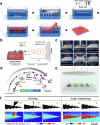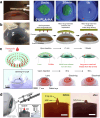Microneedles for controlled and sustained intraocular drug delivery
- PMID: 40860929
- PMCID: PMC12370535
- DOI: 10.1038/s41427-025-00614-7
Microneedles for controlled and sustained intraocular drug delivery
Abstract
Microneedles (MNs) have emerged as a promising technology for minimally invasive drug delivery, offering significant advantages in the treatment of ocular diseases. These miniaturized needles enable precise, localized drug delivery directly into specific tissues of the eye, such as the cornea, sclera, vitreous, or retina, while minimizing pain and discomfort. MNs can be fabricated from various biocompatible materials, including metals, silicon, and biodegradable polymers, making them highly adaptable to various clinical applications. Recent advancements in MN design include the integration of 3D printing technologies to create highly customized geometries for improved drug delivery precision, the use of smart materials that enable stimuli-responsive and sustained drug release, and the development of hybrid microneedles combining different polymers to enhance both mechanical strength and controlled drug release. These innovations have established MNs as a superior alternative to traditional methods like eye drops or intravitreal injections, which often face issues of limited bioavailability and patient compliance. This review summarizes the current state of research on MN-based ocular drug delivery, focusing on material developments, fabrication methods, drug release mechanisms, and implantation techniques. Future directions for MN technology in ophthalmology are also discussed, highlighting its potential to improve treatment outcomes for complex ocular diseases.
Keywords: Biomaterials; Biomedical engineering.
© The Author(s) 2025.
Conflict of interest statement
Conflict of interestThe authors declare no competing interests.
Figures







Similar articles
-
Prescription of Controlled Substances: Benefits and Risks.2025 Jul 6. In: StatPearls [Internet]. Treasure Island (FL): StatPearls Publishing; 2025 Jan–. 2025 Jul 6. In: StatPearls [Internet]. Treasure Island (FL): StatPearls Publishing; 2025 Jan–. PMID: 30726003 Free Books & Documents.
-
Management of urinary stones by experts in stone disease (ESD 2025).Arch Ital Urol Androl. 2025 Jun 30;97(2):14085. doi: 10.4081/aiua.2025.14085. Epub 2025 Jun 30. Arch Ital Urol Androl. 2025. PMID: 40583613 Review.
-
Designing Multifunctional Microneedles in Biomedical Engineering: Materials, Methods, and Applications.Int J Nanomedicine. 2025 Jul 4;20:8693-8728. doi: 10.2147/IJN.S531898. eCollection 2025. Int J Nanomedicine. 2025. PMID: 40630938 Free PMC article. Review.
-
Microneedle-Mediated Delivery for Targeted Cancer Therapy: A Comprehensive Review.Crit Rev Ther Drug Carrier Syst. 2025;42(5):101-120. doi: 10.1615/CritRevTherDrugCarrierSyst.2025053964. Crit Rev Ther Drug Carrier Syst. 2025. PMID: 40743617 Review.
-
Current 3D Printing Technologies and Their Potential Applications in Drug Delivery, Personalized Medicine & Pharmaceutical Sciences.Curr Drug Discov Technol. 2025 Aug 22. doi: 10.2174/0115701638392138250722112310. Online ahead of print. Curr Drug Discov Technol. 2025. PMID: 40873165
References
-
- Sabri, A. H. et al. Expanding the applications of microneedles in dermatology. Eur. J. Pharm. Biopharm.140, 121–140 (2019). - PubMed
-
- Park, H., Park, W. & Lee, C. H. Electrochemically active materials and wearable biosensors for the in situ analysis of body fluids for human healthcare. NPG Asia Mater.13, 23 (2021).
-
- Zheng, M., Sheng, T., Yu, J., Gu, Z. & Xu, C. Microneedle biomedical devices. Nat. Rev. Bioeng.2, 324–342 (2024).
-
- Glover, K. et al. Microneedles for advanced ocular drug delivery. Adv. Drug. Deliv. Rev. 201, 115082 (2023). - PubMed
Publication types
LinkOut - more resources
Full Text Sources
